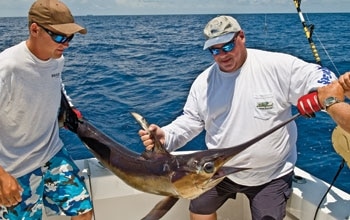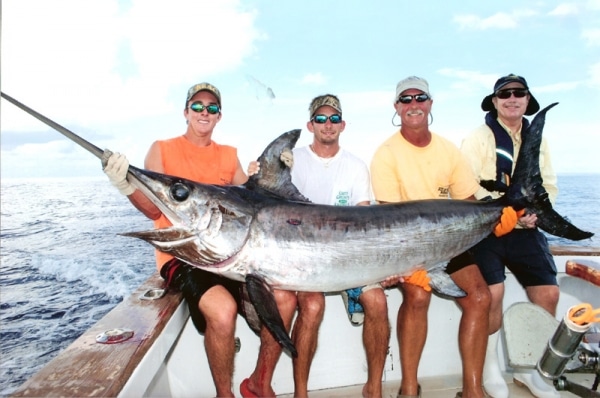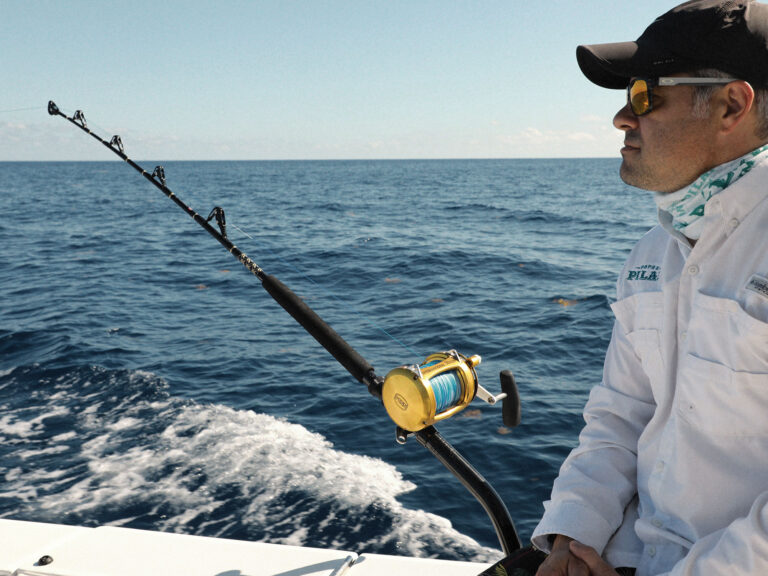[Daytime swordfishing is the hottest fishery in South Florida, and no one is better at it than Bill Dobbelaer of Lighthouse Point. It’s not for everyone, but if this specialized fishing appeals to you, follow these five suggestions and you’ll be well on your way to success.]
**

- Drop Carefully**
“In most fishing, the sport is in the fight, but here the trick is in presenting the baits correctly,” says Bill Dobbelaer, general manager of Global Fish Mounts (www.globalfishmounts.com), in Pompano Beach, Florida. Daytime swordfishing off Fort Lauderdale takes place in the Gulf Stream in 1,500 to 1,800 feet of water over seamounts. You have to know where your baits are at all times to keep from hanging them up. Dobbelaer uses a 150-foot wind-on leader with a 10- to 12-pound stick lead at the upper end of the leader, just below the Dacron-to-mono splice. When deploying baits, he heads north, down-current, while the angler slowly lets out line.
He makes a three-step drop, letting out a third of the line at a time, taking up slack in between. The leader must remain stretched out behind the boat, where it won’t tangle with the main line. Baits are rigged to swim on tandem in-line hooks. The more easily the rig moves through the water, the less it’s going to tangle on itself.
After the second pause to take up slack, the angler drops all the way to the bottom. When the lead hits the ocean floor, he yells “bottom” and begins retrieving line as Dobbelaer turns the boat 180 degrees to head south, into the current. The angler continues retrieving line as Dobbelaer powers into the current, keeping a close eye on the angle of the line as it leaves the rod tip.
When the line is perpendicular to the surface, the angler drops again until it hits bottom, then reels up a few feet and he’s fishing. Dobbelaer bumps the boat along, keeping the line vertical while the angler drops every so often to find bottom. This keeps the bait in the strike zone and out of the rocks. The weight hangs on a 30-foot dropper, with a short section of breakaway line just above it. If you hang up on the rocks, you want it to be the lead; if the hook hangs up, you lose the lead, the wind-on and a lot of expensive braided line.
Dobbelaer uses 65- and 80-pound-test, solid-core braided line. “We tried heavier braid,” he says, “but it offers too much resistance.” The thinner diameter of lighter braids makes it easier to find bottom in strong current, yet provides enough muscle to fight large fish.
**

- Sew It Up**
When fishing deep waters, you don’t want to reel in your line except when you have to: Even electric reels take over 10 minutes to regain 1,800 feet of line, so you need a sturdy bait. Sewn belly baits work best. Although swordfish love squid, they’re fragile, and easily mutilated or pulled off a hook. When fishing squid, you have to assume that your bait needs to be replaced after every strike.
Swordfish often attack a bait repeatedly before eating it, so you need something durable. We used dolphin bellies sewn together and also caught a sword on belly strips from a rainbow runner. Dobbelaer and crew have actually caught multiple swordfish on the same dolphin-belly bait.
3. Use Enough Lead

You need weight to get down 1,800 feet in strong current – lots of weight. Some daytime swordfish pros use sacrificial weights made of concrete to get deep, counting on them to break off when the fish bite. You have to rig this way when using hand-cranked gear, as you don’t want to be fighting both a hefty swordfish and 10 to 15 pounds of weight on a manual reel.
But Dobbelaer rigs with the expectation of getting the lead back. The 30-foot dropper line clips onto the wind-on just past the mono-to-Dacron splice, held in place between two knots made of waxed thread and whipped onto the leader. When the angler gets the wind-on on the reel, simply unclip the dropper line and wind it up by hand. If you’re unlucky and hang the lead in a rock far below, the section of light mono breaks and you lose only the lead.
These leads cost around $30 apiece, but the streamlined profile of the stick leads allows them to drop better than bulky concrete weights, with less flutter and therefore less chance of becoming tangled with the main line. The currents off Miami and Fort Lauderdale run much stronger than they do in the Florida Keys, the other daytime swordfishing hot spot, and you need to do everything within your power to keep your terminal tackle tangle-free.
4. Find and Fish Structure

Irregular bottom contours provide opportunities for swordfish to ambush bait. The current sweeps over these undersea mounds, creating eddies and crosscurrents. Working these structures will provide consistent action. Dobbelaer watches his sounder as intently as he watches the rod tip, announcing approaching seamounts so the angler can adjust the bait accordingly and keep it in the proper zone, just above the bottom.
While swordfishing, the Gulf Stream current constantly sweeps the boat northward, so even though the bow points south, you’re really traveling backward with the current, to the north. With the line straight down, 1,800 feet beneath the boat, your bait actually drifts along about 150 feet in front of the boat. The wind-on rides parallel to the bottom, so if the weight rides 10 feet above the bottom at the end of a 30-foot dropper, your bait should be 150 feet south, 40 feet off the bottom.
Dobbelaer and crew get excited when coming off the back of a large seamount. “We get a lot of bites on the backside of large seamounts,” Dobbelaer says, “so we assume they lie there waiting for prey to be swept by in the current.” Working these mounds requires precise coordination between captain and angler, with frequent drops by the angler to re-establish contact with the bottom.
5. Watch the Tip!

The tip tells you everything, so learning to distinguish real strikes from errant motions is key. Remember that the fish is biting the bait almost 2,000 feet away from you – a slightly irregular bob of the tip could be a 40-pounder slashing at the bait with its bill, or it could mean a 500-pounder has just engulfed your bait. Quick reactions make the difference, and you need to come tight quickly to hook one in the mouth and not the gut. When you wind down on a suspected bite, you’ll soon know whether there’s a fish on the other end of the line. Only practice will provide you with keen eyes like those already developed by daytime swordfish aces like John Bassett and Bill Dobbelaer.
Trip Planner

Swordfish bite all year off South Florida, but the bigger fish return from the Caribbean in the fall and winter. Prime grounds run from Key West to Palm Beach, but the irregular bottom offshore of Fort Lauderdale has proven to be particularly productive. On two separate daytime swordfish trips with Dobbelaer, we hooked more than 10 fish, caught three, and pulled the hook on several right at the boat. The action comes with surprising frequency – the mass of fish down there must be huge given the number of bites and the amount of territory we were fishing, literally hundreds of square miles of water.
What: Broadbill swordfish.
When: Year-round, with larger fish in fall and winter.
Where: Atlantic Gulf Stream waters off South Florida.
Who: The following South Florida charter captains have made names for themselves as knowledgeable daytime swordfishing experts and can easily put you on a trophy broadbill of your own.
Capt. Bouncer Smith
305-439-2475
www.captbouncer.com
Capt. Ray Rosher
305-596-0419
www.missbritt.com
Capt. Jimmy David
305-361-9318
www.landhsportfishing.com
Capt. Steve Huddleston
954-562-0051
www.captpumpkineater@hotmail.com
Capt. Dean Panos
954-805-8231
www.doubledcharters.com









